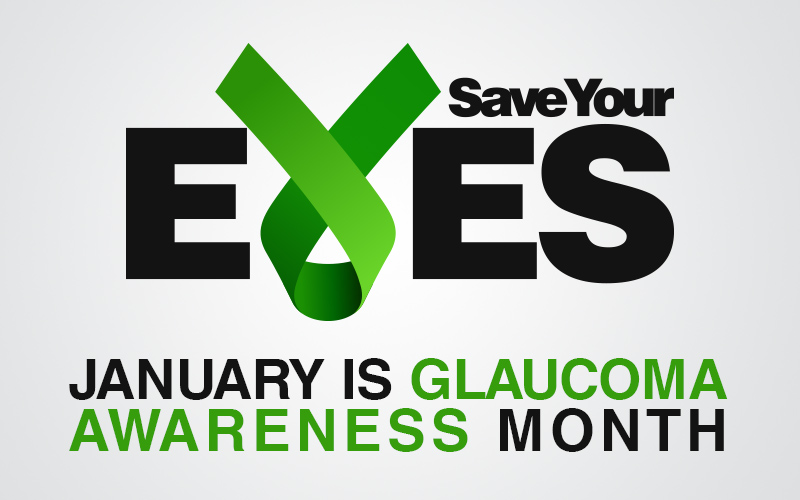Glaucoma Awareness Month: What's my risk for developing glaucoma?

January is glaucoma awareness month. As an optometric provider, one of the eye diseases that I would see fairly commonly in my practice is glaucoma. Now, I worked in a Veterans Affairs hospital, so my patient base just due to age was at a higher risk for this disease. Glaucoma itself is a disorder that can be easily managed if caught early. The biggest misconception about glaucoma is that you lose clarity of vision. Basically, blurry vision equates to something wrong and causes someone to seek an eye examination. But 20/20 vision does not mean your eyes are healthy. Glaucoma actually robs us of sight, but from peripheral vision first. It only affects central vision (and then the ability to see clearly) much, much later in the disease process. To rule out disorders like this, a dilated examination is needed. In this three-part blog post, I’ll discuss some of my musings on glaucoma first and follow-up with a more in-depth discussion on the disease process as well as what a glaucoma examination looks like.
Quick Glaucoma Stats
Let’s take a minute to look at some statistics and discuss this silent theft of sight. In 2000, the National Eye Institute estimated 2.22 million cases of glaucoma in the U.S. By 2010, this had risen 23% to 2.72 million cases. Projections estimate over 4 million cases of glaucoma by 2030 and over 6 million cases by 2050. Unfortunately, glaucoma is asymptomatic in the early and middle stages of the disease. Without a comprehensive eye examination, most patients have no idea they are either at-risk for or have already progressed to the point of irreversible vision loss.1
Projections estimate over 4 million cases of glaucoma by 2030 and over 6 million cases by 2050.
Who exactly is at risk? Take a look at the stats from the National Eye Institute (Figure 1). There are a few key trends to take note of. First, glaucoma can affect all ages. However, as you can see by the graph, the prevalence of glaucoma increases sharply with age. Second, all races can be affected by glaucoma. In 2010, glaucoma affected about 1.9 percent of people in the U.S. age 40 and older. Black Americans had the highest prevalence rate (3.4 percent) followed by Americans of other races (2.1 percent), whites (1.7 percent), and Hispanics (1.5 percent).1 Now, this assumes that the patients in the survey had what is called open-angle glaucoma. There’s actually a number of less-common types of glaucoma that may occur due to trauma, congenital disorders, secondary to other health conditions, etc.
Genetics and family history (that is, a primary relative having glaucoma) both play a role, however just how much of a role genetics plays is still unanswered. Patients suffering from medical conditions such as diabetes, hypertension (high blood pressure), heart disease, and frequent migraines have a slightly higher risk of developing glaucoma. Even some medications, such as corticosteroids such as prednisone, can put a patient at risk for glaucoma if used for a long period of time. We consider family history, health conditions, medication use, etc. to be risk factors rather than a guarantee that a patient will develop glaucoma.

Figure 1: Prevalence Rates from NEI
The Office of Disease Prevention and Health Promotion (aptly shortened to ODPHP) understand the importance of vision health for all. As such, part of the Healthy People 2020 health goals and objectives is to “improve the visual health of the Nation through prevention, early detection, timely treatment, and rehabilitation.” This included an investigation into the benefits of glaucoma screening.2 This investigation was carried out by the U.S. Preventive Services Task Force (USPSFT). Interesting, the USPSFT could not determine the benefit of glaucoma screenings.3
So, with a disease that is one of the primary causes of vision loss in aging adults (the others being macular degeneration and cataract) why couldn’t they find a benefit to glaucoma screenings? Well, the answer lies in the nature of the disease. The diagnosis of glaucoma is often not black-and-white. Now, it’s true that a rare patient will walk into the office with incredibly high intraocular pressure (IOP) and severely damaged optic nerves, but this the exception rather than the rule. In fact, for some patients, glaucoma would progress so slowly that it may not impact a patient’s vision. Most often a patient’s IOP is borderline or slightly elevated and the optic nerve may have a “suspicious” appearance on clinical evaluation. The clinician then makes a recommendation of a battery of tests including interocular pressure measurement(s), optic nerve imaging, and visual field examination - we’ll discuss this in a little more detail in my next post.
This is part 1 of a 3 part series on glaucoma. Stay tuned for the next part in a week!
- Glaucoma, open-angle. National Eye Institute. https://nei.nih.gov/eyedata/glaucoma. Accessed January 1, 2018.
- Office of Disease Prevention and Health Promotion. Healthypeople.gov website. https://www.healthypeople.gov/2020/topics-objectives/topic/vision?topicid=42. Accessed January 1, 2018.
- Final recommendation statement glaucoma: screening. U.S. Preventive Services Task Force. https://www.uspreventiveservicestaskforce.org/Page/Document/RecommendationStatementFinal/glaucoma-screening#consider. Accessed January 1, 2018.
